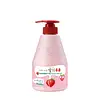What's inside
What's inside
 Key Ingredients
Key Ingredients

 Benefits
Benefits

 Concerns
Concerns

 Ingredients Side-by-side
Ingredients Side-by-side

Water
Skin ConditioningAmmonium Lauryl Sulfate
CleansingAmmonium Laureth Sulfate
CleansingCocamidopropyl Betaine
CleansingSodium Chloride
MaskingStyrene/Vp Copolymer
Fragaria Chiloensis Fruit Extract
Skin ConditioningSodium Sulfate
Laureth-3
EmulsifyingCitric Acid
BufferingButylene Glycol
HumectantPanthenol
Skin ConditioningHoney Extract
HumectantAlcohol
AntimicrobialMilk Protein Extract
Propolis Extract
Skin ConditioningRoyal Jelly Extract
Skin ConditioningDisodium EDTA
Sodium Benzoate
MaskingPhenoxyethanol
PreservativeCI 19140
Cosmetic ColorantCI 17200
Cosmetic ColorantParfum
MaskingLinalool
PerfumingWater, Ammonium Lauryl Sulfate, Ammonium Laureth Sulfate, Cocamidopropyl Betaine, Sodium Chloride, Styrene/Vp Copolymer, Fragaria Chiloensis Fruit Extract, Sodium Sulfate, Laureth-3, Citric Acid, Butylene Glycol, Panthenol, Honey Extract, Alcohol, Milk Protein Extract, Propolis Extract, Royal Jelly Extract, Disodium EDTA, Sodium Benzoate, Phenoxyethanol, CI 19140, CI 17200, Parfum, Linalool
Water
Skin ConditioningSodium Laurylglucosides Hydroxypropylsulfonate
CleansingCaprylyl/Capryl Glucoside
CleansingDisodium Cocoamphodiacetate
CleansingGlycerin
HumectantSodium Chloride
MaskingSodium Methyl Cocoyl Taurate
CleansingNiacinamide
SmoothingTocopherol
AntioxidantSaccharum Officinarum Extract
MoisturisingPyrus Malus Fruit Extract
Skin ConditioningCitrus Aurantium Dulcis Fruit Extract
MaskingCitrus Limon Fruit Extract
MaskingCamellia Sinensis Leaf Extract
AntimicrobialSclerocarya Birrea Seed Oil
HumectantCaryodendron Orinocense Seed Oil
EmollientLimnanthes Alba Seed Oil
Skin ConditioningCaprylyl Glycol
EmollientPhenoxyethanol
PreservativeCitric Acid
BufferingChlorphenesin
AntimicrobialSodium Phytate
Water, Sodium Laurylglucosides Hydroxypropylsulfonate, Caprylyl/Capryl Glucoside, Disodium Cocoamphodiacetate, Glycerin, Sodium Chloride, Sodium Methyl Cocoyl Taurate, Niacinamide, Tocopherol, Saccharum Officinarum Extract, Pyrus Malus Fruit Extract, Citrus Aurantium Dulcis Fruit Extract, Citrus Limon Fruit Extract, Camellia Sinensis Leaf Extract, Sclerocarya Birrea Seed Oil, Caryodendron Orinocense Seed Oil, Limnanthes Alba Seed Oil, Caprylyl Glycol, Phenoxyethanol, Citric Acid, Chlorphenesin, Sodium Phytate
 Reviews
Reviews

Ingredients Explained
These ingredients are found in both products.
Ingredients higher up in an ingredient list are typically present in a larger amount.
Citric Acid is an alpha hydroxy acid (AHA) naturally found in citrus fruits like oranges, lemons, and limes.
Like other AHAs, citric acid can exfoliate skin by breaking down the bonds that hold dead skin cells together. This helps reveal smoother and brighter skin underneath.
However, this exfoliating effect only happens at high concentrations (20%) which can be hard to find in cosmetic products.
Due to this, citric acid is usually included in small amounts as a pH adjuster. This helps keep products slightly more acidic and compatible with skin's natural pH.
In skincare formulas, citric acid can:
While it can provide some skin benefits, research shows lactic acid and glycolic acid are generally more effective and less irritating exfoliants.
Most citric acid used in skincare today is made by fermenting sugars (usually from molasses). This synthetic version is identical to the natural citrus form but easier to stabilize and use in formulations.
Read more about some other popular AHA's here:
Learn more about Citric AcidPhenoxyethanol is a preservative that has germicide, antimicrobial, and aromatic properties. Studies show that phenoxyethanol can prevent microbial growth. By itself, it has a scent that is similar to that of a rose.
It's often used in formulations along with Caprylyl Glycol to preserve the shelf life of products.
Chances are, you eat sodium chloride every day. Sodium Chloride is also known as table salt.
This ingredient has many purposes in skincare: thickener, emulsifier, and exfoliator.
You'll most likely find this ingredient in cleansers where it is used to create a gel-like texture. As an emulsifier, it also prevents ingredients from separating.
There is much debate on whether this ingredient is comedogenic. The short answer - comedogenic ratings don't tell the whole story. Learn more about comegodenic ratings here.
The concensus about this ingredient causing acne seems to be divided. Research is needed to understand if this ingredient does cause acne.
Scrubs may use salt as the primary exfoliating ingredient.
Learn more about Sodium ChlorideWater. It's the most common cosmetic ingredient of all. You'll usually see it at the top of ingredient lists, meaning that it makes up the largest part of the product.
So why is it so popular? Water most often acts as a solvent - this means that it helps dissolve other ingredients into the formulation.
You'll also recognize water as that liquid we all need to stay alive. If you see this, drink a glass of water. Stay hydrated!
Learn more about Water